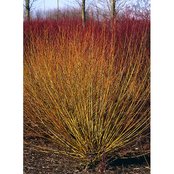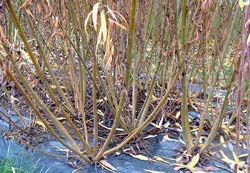Home --> About the Park --> Willows in the Park
Willows in the Park |
|
“...the valley of the Trent and its tributaries is the most important district in England, for both osier growing and basket making, not only for quality of output, but also quality of rods, and care given to their cultivation and for the fineness of the basketry done there”
- Rural Industries Survey, Agricultural Research Institute, Oxford, 1926. Authors – FitzRandolph and Hay.
Little remains of this once famous willow growing and working, and with this fact in mind the Trustees of Gedling Country Park have decided to re-introduce the growing and working of Willows in Gedling. The village of Gedling supported two basket makers prior to 1850 but no records exist for the 20th century
We, the Friends of Gedling Country Park (FGCP), have already commenced working with Willows creating a woven walkway with arched tunnels, a Celtic type roundhouse for a children discovery area and we are constructing natural living bird-hides within the park.
- Rural Industries Survey, Agricultural Research Institute, Oxford, 1926. Authors – FitzRandolph and Hay.
Little remains of this once famous willow growing and working, and with this fact in mind the Trustees of Gedling Country Park have decided to re-introduce the growing and working of Willows in Gedling. The village of Gedling supported two basket makers prior to 1850 but no records exist for the 20th century
We, the Friends of Gedling Country Park (FGCP), have already commenced working with Willows creating a woven walkway with arched tunnels, a Celtic type roundhouse for a children discovery area and we are constructing natural living bird-hides within the park.
|
We wish to introduce Willow weaving, basket making and the creation of living structures for the FGCP, local schools and visitors to the park. With this in mind we have to plant and cultivate a selection of suitable Willow varieties, a collection that will also be used for demonstration, supply and conservation purposes.
Also the FGCP run an apiary on site and certain Willow species are important providers of early food for honeybees hence the intention of also planting catkin bearing native Willow species in the park. |
We intend to plant a display bed near to the Friends hut and the working specimens will be planted at various suitable locations throughout the park. The varieties Lemon Rose and Silberglanz will also be planted close to the beehives to act as a windbreak and also as an early spring food source for our bees
As of January 2017, we have purchased cuttings of the following Willows and will be planting these in the park during January/February:
As of January 2017, we have purchased cuttings of the following Willows and will be planting these in the park during January/February:
|
Golden – This willow is gorgeous, once extensively used as a basketry willow it now excels as an ornamental shrub. In spring the new growth is very attractive with bright foliage, but it really comes into its own in the winter when it offers some of the best winter colour.
It has strong yellow rods with orange, almost red, tops. As a basketry willow the rods are nice, straight and even but it can be quite brittle. Used for floristry, basketry, living structures, winter colour, hedging and windbreaks. |
|
Flanders Red – A very nice ornamental basketry willow with rods that grow up to 3m in length. It’s waxy skin surface makes the rods really nice to work and it is much sort after by Basketmakers.
When young it is more green than red but has an attractive red blush to the rod tips which darkens in winter. It is a fast growing willow so needs to be well coppiced each year. The rods dry to a rich brown. Used for basketry and great winter colour. |
|
Golden Rod – Does not have the intense yellow of some of the other alba vitellina varieties but is a beautiful combination of attractive winter colour and very long straight unbranched rods. This makes it wonderful for adding colour to living structures or creating a colourful hedge or windbreak. Nice and flexible, this willow can also be woven fresh with ease, great for agricultural basketry.
A reasonably fast growing willow so needs coppicing annually to get the best colours. Rods have a green butt getting yellower towards the tip and finishing with a red blush, bright red buds stand out against the stem. Used for basketry, living structures, winter colour, hedging and windbreaks. |
|
Honey – This variety grows extremely fine rods which are long and straight, up to 3 metres in a year. The rods can be quite tall with little branching and bear the typical narrow leaves of S. Viminalis but wider than some and without any bloom.
It has honey coloured stems which make a nice contrast to many of the green varieties. The rods dry to a light brown. Used for living structures, course basketry hedging and windbreaks. |
|
Silver – A very lush, vigorous willow with strong olive green rods sporting a red hue in spring, darkening and turning a honey colour in winter. Rods grow strong and tall with little branching. Can reach over 3 metres per year. Used for agricultural basketry, living structures, hedging and windbreaks. |
|
Jaune Hative – This is a beautifully coloured French basketry willow, green at the base turning a wonderful yellow, orange, through to red at the tips. Rods are substantial, up to 2 metres long with a waxy surface. New growth in spring produces lovely golden/red stems and fresh bright green leaves. Rods dry to a dark honey-brown colour. Used for basketry, winter colour, hedging and windbreaks. |
|
Black Maul – This is the main willow variety grown in Somerset for basketry because of its weaving quality. It was also widely used in the Trent Valley as a basketry willow and was probably the national favourite. It is also frequently stripped of its bark and used to make both white and buff willow. The rod is olive green but has attractive new growth which is maroon/black turning olive green/brown as it matures. The rods are long and once established can reach over 3 metres tall. They are slander and very flexible. The bark is smooth and dark grey/olive and flakes off in patches revealing a red-brown under layer. Unfortunately it is prone to disease so not ideal for living willow structures. Used for basketry, hedging and windbreaks. |
|
Silberglanz – This willow is a must for the lover of catkins and strong winter colour in the garden. Has lovely burgundy rods which become quite dark over winter and develop beautiful bright red bud scales which look like small jewels along the stem. In spring fat silver catkins emerge making it a must for flower arrangements. It has some of the best catkins, and certainly the best bud scales, of any willow we know of. Rods grow about 3 metres when established and it does branch. Used for floristry, winter colour, catkins, bees and insects. |
Lemon Rose – This is one of the best willows for catkins which are nice and fat and lemon and rose in colour. Quite woody and shrub-like with grey older wood and branching stems.
New growth has green-burgundy stems and fantastic red bud scales form on the rods over winter which then produce lovely fat pussy willow catkins. It has broad leaves with furry undersides and a pink-rose blush. Used for floristry, catkins, bees, insects, hedging and windbreaks.
Should anyone have experience of willow weaving and/or would like to become involved in this project please contact us.













